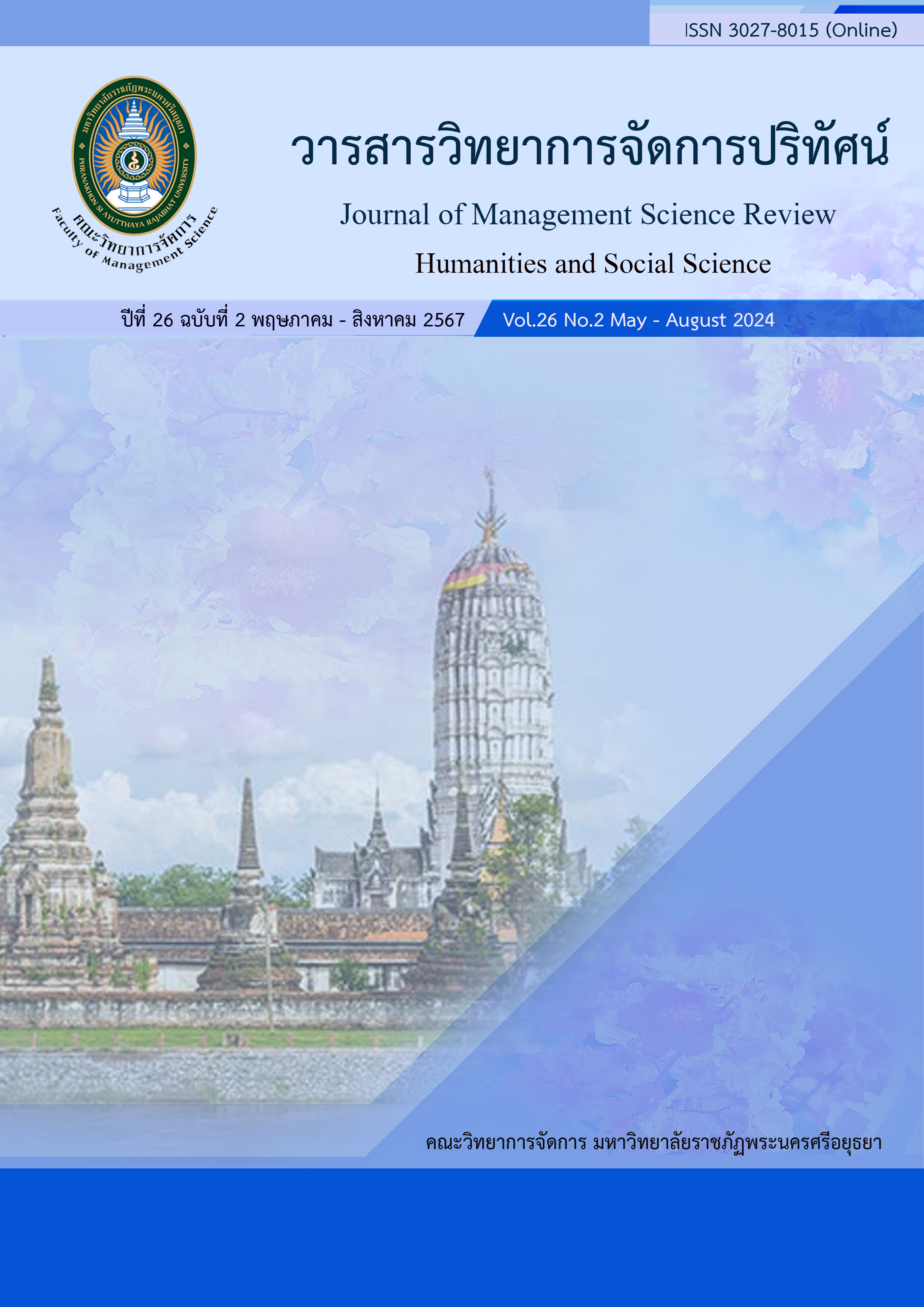อิทธิพลเชิงสาเหตุของประสบการณ์ตราสินค้าต่อความภักดีในตราสินค้าเครื่องประดับอัญมณี ในกลุ่ม Gen Y จังหวัดจันทบุรี
คำสำคัญ:
ประสบการณ์ตราสินค้า, ความภักดีในตราสินค้า, เครื่องประดับอัญมณี, เจเนอเรชั่นวายบทคัดย่อ
การศึกษาเรื่องนี้มีวัตถุประสงค์เพื่อศึกษาอิทธิพลเชิงสาเหตุของประสบการณ์ตราสินค้าต่อความภักดีในตราสินค้าเครื่องประดับอัญมณีกลุ่ม Gen Y ในจังหวัดจันทบุรี โดยประชากรและกลุ่มตัวอย่างที่ใช้ในการศึกษา คือ ผู้บริโภคเพศหญิงที่มีอายุระหว่าง 28-43 ปี (กลุ่ม Gen Y) จังหวัดจันทบุรี ที่เคยซื้อ/หรือเคยสวมใส่เครื่องประดับอัญมณี จำนวน 385 คน โดยมีวิธีการสุ่มตัวอย่างแบบหลายขั้นตอน เก็บรวบรวมข้อมูลด้วยแบบสอบถาม นำข้อมูลมาวิเคราะห์ด้วยความถี่ ร้อยละ ค่าเฉลี่ย ค่าเบี่ยงเบนมาตรฐาน และสถิติสําหรับทดสอบสมมติฐาน การวิเคราะห์การถดถอยพหุคูณแบบขั้นตอน
ผลการศึกษา พบว่า ผู้ตอบแบบสอบถามส่วนใหญ่มีอายุระหว่าง 33-37 ปี เคยซื้อ/หรือเคยสวมใส่เครื่องประดับอัญมณีจังหวัดจันทบุรี ดำรงสถานภาพโสด ประกอบอาชีพข้าราชการ/ รัฐวิสาหกิจ ระดับการศึกษา ปริญญาตรี และมีรายได้เฉลี่ยต่อเดือนระหว่าง 10,001-30,000 บาท ซื้อเครื่องประดับอัญมณีของจังหวัดจันทบุรี 2-3 ตราสินค้าเป็นประจำ ซื้อเครื่องประดับมากกว่า 3 ครั้งต่อเดือน วัตถุประสงค์ในการซื้อเครื่องประดับอัญมณีเพื่อการลงทุนและใส่ในโอกาสไปร่วมงานพิธีต่าง ๆ ผลการทดสอบสมมติฐาน พบว่า ตัวแปรประสบการณ์ตราสินค้าที่มีอิทธิพลต่อความภักดีในตราสินค้าเครื่องประดับอัญมณีจังหวัดจันทบุรีของผู้บริโภคมี 2 ปัจจัย คือ ประสบการณ์ตราสินค้าด้านความสัมพันธ์ และด้านพฤติกรรม
เอกสารอ้างอิง
Aaker, D. A., Kumar, V., & Day, G. S. (2001). Marketing research. John Wiley & Sons.
Abed, G.M., & Haghighi, M. (2009). The effect of selling strategies on sales performance. Business Strategy Series, 10(5), 266-282.
Adhilla, F. (2015). Salesperson role model in creating customer loyalty at department store. International Journal of Business and Management Invention, 4(3), 44-50.
Adjei, M. T., & Clark, M. N. (2010). Relationship marketing in a B2C context: The moderating role of personality traits. Journal of Retailing and Consumer Services, 17(1), 73–79.
Ahmad, S. Z., Basir, M. S., & Kitchen, P. J. (2010). The relationship between sales skills and salesperson performance, and the impact of organizational commitment as a moderator: An empirical study in a Malaysian telecommunications company. International Journal of Economics and Management, 4(2), 181–211.
Amanuel, H. (2016). Salesperson personality and customer satisfaction [Master’s thesis].
Addis Ababa University.
Berman, B. R., & Evans, J. R. (2012). Retail management: A strategic approach (12th ed.).
Prentice Hall.
Donovan, D. T., Brown, T. J., & Mowen, J. C. (2004). Internal benefits of service-worker customer orientation: Job satisfaction, commitment, and organizational citizenship behavior. Journal of Marketing, 68(1), 128–146.
Dwyer, F. R., Schurr, P. H., & Oh, S. (1987). Developing buyer-seller relationships. Journal of Marketing, 51(2), 11-27. https://doi.org/10.1177/002224298705100202
Eden, B. (2014). The impact of salesperson behavior on trust [Master’s thesis]. University of Nairobi.
Edwards, M. R. (2005). Employer and employee branding: HR or PR?. In S. Bach (Ed.), The management of human resources: Personnel management in transition (pp. 266–286). Blackwell.
Fornell, C. (1992). A National customer satisfaction barometer: The swedish experience. Journal of Marketing, 56(1), 6-21. https://doi.org/10.1177/002224299205600103
Gwinner, K. P., Gremler, D. D., & Bitner, M. J. (1998). Relational benefit in service industries: The customer’s perspective. Journal of the Academy of Marketing Science, 26(2), 101–114.
Hair, J. F., Black, W. C., Babin, B. J., & Anderson, R. E. (2010). Multivariate data analysis: A global perspective (7th ed.). Pearson Prentice Hall.
Kim, H. K., & Lee, T. J. (2018). Brand equity of a tourist destination. Sustainability, 10(2), 431.
Kotler, P. (1997). Marketing management: Analysis, planning, implement, and control (9th ed.). Prentice-Hall.
Lee, J. Y., & Welliver, M. C. (2018). The role of strategic leadership for learning on the relationship between training opportunities and salesperson job performance and commitment. European Journal of Training and Development, 42(7), 558–576.
Lertchakorn, P. (2017). Website quality, trust, perceived value, rating, and feedback affecting decision to purchase products via eBay of customers in Bangkok. [Master’s thesis]. Bangkok University.
Mikias, S. (2016). The effect of salesperson personality on customer satisfaction. [Master’s thesis]. Addis Ababa University.
Oliver, R. L. (2010). Satisfaction: A behavioral perspective on the consumer (2nd ed.). McGraw-Hill.
Pezhman, R., Javadi, M. H. M., & Shahin, A. (2013). Analyzing the influence of ethical sales behavior on customers loyalty through customer satisfaction and trust in insurance company. International Journal of Academic Research in Business and Social Sciences, 3(9), 754-763.
Pinsuwan, S. (2012). Qualifications of sales assistants affecting satisfaction of their service quality among working women in Bangkok: A case study of Payot brand. [Master’s thesis].
Bangkok University.
Prasertphol, N., & Phasunon, P. (2021). The canonical correlation analysis between marketing mix and decision factors to choosing Shop Up website service of Netdesign Host Company Limited. Journal of Management and Development Ubon Ratchathani Rajabhat University, 8(1), 15-26.
Promhitatorn, M., & Prapratanpron, B. (2020). Attitude and strategy of using direct salesmen influencing decision-making for purchasing direct sale agricultural products (type of fertilizer) of customers in Surat Thani Province. Journal of Management Science Review, 22(1), 69–79.
Reichheld, F. F., & Sasser, E. (1990) Zero Defections: Quality Comes to Services. Harvard Business Review, 68, 105-111.
Reynolds, K. E., & Beatty, S. E. (1999). Customer benefits and company consequences of customer-salesperson relationships in retailing. Journal of Retailing, 75(1), 11–32.
Valenzuela, L., Torres, E., Hidalgo, P., & Farías, P. (2014). Salesperson CLV orientation's effect on performance. Journal of Business Research, 67(4), 550-557.
Vanichbancha, K. (2014). Statistics for research (7th ed.). Thammasat University.
Wiles, M.A. (2007). The effect of customer service on retailers’ shareholder wealth: The role of availability and reputation cues. Journal of Retailing, 83, 19–31.





